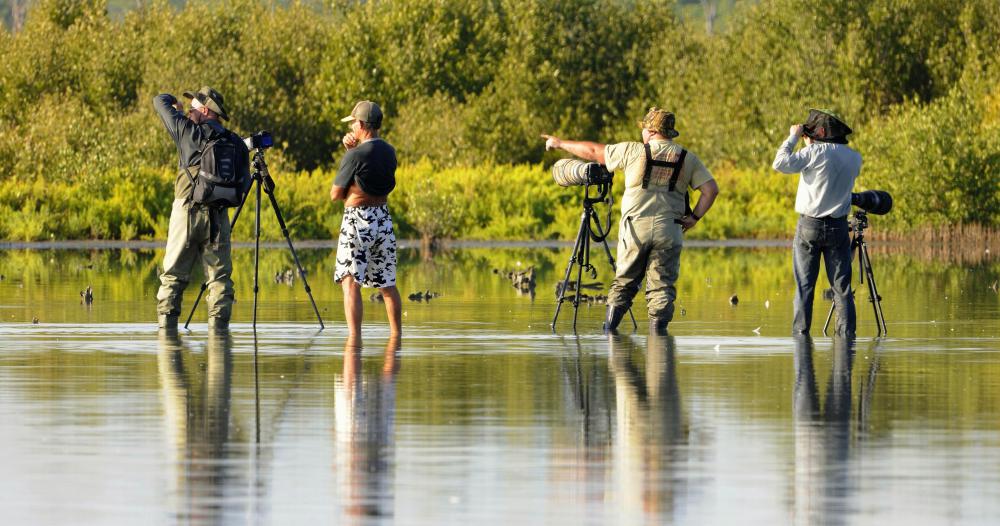What is a Native Species?
 Mary McMahon
Mary McMahon
A native species is an organism that is living in an area for entirely natural reasons, with no human intervention involved. This may be because the organism evolved in that environment, or it may have been brought there by natural causes. Wind can spread plant seeds widely for example, and species may be carried by animals or birds; individuals may also migrate seeking food or territory. By contrast, a non-native species has been introduced, intentionally or accidentally, by humans and may become invasive, taking over the natural environment and choking out native species. Invasive species often develop quickly and spread aggressively, making it difficult for natives to compete.
Over time, a native species usually evolves to perfectly fit in the environment where it has settled. Subspecies that have refined themselves to take advantage of subtle variations in the environment can also develop, and some of these may eventually evolve into new species. This increase in specialization, however, can render an organism less able to cope with changes in its environment
Endemic and Indigenous Species

Two types of native species are recognized: endemic species are found only in the area concerned, while indigenous species are also found naturally in other areas. Endemic organisms are particularly vulnerable to extinction as they may be confined to a very small region and to particular habitats within that region. They may have evolved in a very specialized way, to adapt to an unusual and uncommon environment, and may only be able to survive in a very limited range of conditions.

Populations of indigenous organisms tend to be more robust, as they are more widespread. They have usually evolved to thrive in habitats that are quite commonplace or to be able to adapt to a wide range of conditions. Sometimes, they can recolonize areas from which they have disappeared, and in some cases, they have been reintroduced by humans.
One reason for an organism to be native to a region is because it evolved there. This is seen most commonly on islands, where comparative isolation allows unique species to develop over extended periods of time. Islands consequently tend to have many endemic species, and their distinctive ecologies are very vulnerable. When island environments are disrupted, the native species found nowhere else may quickly become extinct.
The Spreading of Indigenous Species

Indigenous species may have evolved in a habitat where they are found, or they may have arrived there, by natural means, from elsewhere. As organisms have evolved to fit an evolutionary niche, they will spread to other areas where that niche remains unfilled, if they have the means to do so. Transportation of plants and seedlings can occur on wind currents, on the bodies and in the bellies of animals in their natural range, and as a result of putting out shoots and runners. A plant species, for example, can therefore end up covering a very large territory.
Animals spread naturally as their populations increase and they range further in search of food and territory. Native animals may follow seasonal migrational patterns or may relocate their populations periodically in response to various pressures, natural curiosity, or changing landscapes. Some animals travel vast distances in search of new territory; certain bird and insect species are particularly notable for their lengthy migrations.
Threats to Native Species
Native species face a variety of threats to their survival, and some are critically endangered as a result of human activities. A number of animals and birds have been lost in the last few centuries as they have been hunted to extinction. In the present day, destruction of habitats is a major threat, as more land is built over or used for agriculture.
The Protection of Native Species
Recognition of the importance of native species and unique environments has led to the formation of a number of organizations that promote native plants and animals. The International Union for Conservation of Nature (IUCN) maintains lists of endangered and critically endangered species and campaigns to protect their interests. The World Wide Fund for Nature (WWF), formerly known as the World Wildlife Fund, works to help preserve the habitats of native animals, plants, and other organisms, and runs adoption campaigns for endangered animals. At a more local level, there are many organizations that encourage people to use native plants in their gardens, participate in eradication campaigns for invasive organisms, and educate people about the risks to native animal species posed by imported livestock and pets.
AS FEATURED ON:
AS FEATURED ON:













Discussion Comments
@Clairdelune - My daughter is a member of her school's environmental protection club, and from what she tells me, the animals that are most endangered or threatened in the US are the bald eagle -- which I think is a shame, since it's our national animal! -- the pygmy rabbit, the Western pond turtle, and the gray wolf. I may have mixed a few of those up, but I think that's what they're called. I guess it's kind of sad when there are so many endangered animals that you can't even keep them straight!
I'd like to know more about endangered animals, especially those in the United States. Thanks.
This is a very interesting article. I never thought that much about how many conditions affect animal and plant populations. I know where I live, in Oregon, we have some huge problems with invasive species, like nutrias!
In case you don't know (and consider yourself lucky if you've never run into one of these guys) nutrias are fairly large rodent with orange teeth (yuck), were originally brought to the U.S. for the sale of their fur. But they became overpopulated and are now a real nuisance, even in neighborhood ponds.
Now, I know some people think they're cute, but for me, seeing one of those guys in my pond scaring the birds kind of puts me off of them. I say up with native species!
Post your comments